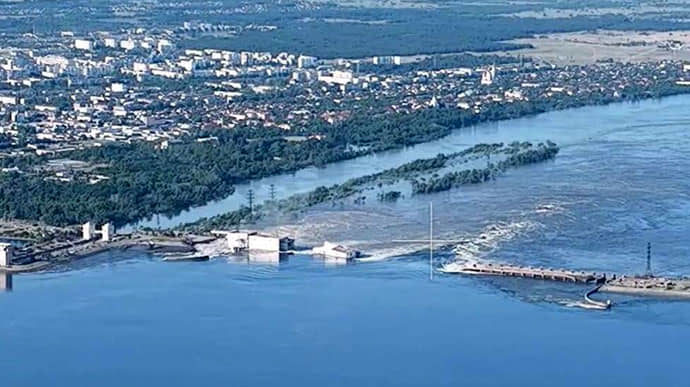Ukraine’s hydropower company Ukrhydroenerho has stated that the Kakhovka Hydropower Plant, blown up by Russian forces in the morning of 6 June, is totally destroyed and cannot be restored, as the explosion happened within the machine room of the station.
Russian troops blow up dam of Kakhovka HPP, unleashing environmental disaster (UPDATING)
Ukrhydroenergo further stated that, “Our experts continue to analyze the situation, working on specifying the extent of the destruction, speed, and volume of water.” As of 9:00 on 6 June, the water level in the Kakhovka reservoir was rapidly decreasing, and the evacuation of people from potential flood zones has begun.
Ukrhydroenergo has also stated that an uncontrolled decrease in the reservoir’s level presents an additional threat to the temporarily occupied Zaporizhzhia Nuclear Power Plant. The water from the Kakhovka reservoir is necessary for the power plant to supply condensers of turbines and safety systems. Currently, the plant’s cooling pond is full, with Ukrainian staff at the Zaporizhzhia Nuclear Power Plant monitoring all indicators.
In response to this situation, the Office of the Prosecutor General has begun an investigation under the article of ecocide, due to the occupant’s destruction of the Kakhovka hydroelectric power station.
The Kakhovka Hydroelectric Power Station: a strategic asset for Ukraine
The Kakhovka Hydroelectric Power Station (HPS) was a run-of-river power plant on the Dnipro (Dnieper) River in Nova Kakhovka, a port city located on the reservoir’s southern bank. The primary purposes of the dam were hydroelectric power generation, irrigation and navigation. It was the sixth and the last dam in the Dnipro reservoir cascade.

The dam was built in 1956 as part of the Kakhovka hydroelectric power plant. The reservoir it contained held an estimated 18 cubic kilometers of water, about the same volume as the Great Salt Lake in Utah. The dam itself was 30 meters tall and hundreds of meters wide. Water from the reservoir supplied the Crimean peninsula to the south – which was annexed by Russia in 2014 – as well as the Zaporizhzhia nuclear plant – Europe’s largest – to the north. It also helped power the Kakhovka hydroelectric plant.
The destruction of the dam adds to Ukraine’s ongoing energy problems, after Russia spent weeks earlier this year targeting vital infrastructure. It also likely wrecks the canal system that irrigates much of southern Ukraine, including Crimea.
On 24 February 2022, the power plant was captured by Russian forces during their invasion of Ukraine. During weeks of artillery attacks by Ukraine in August and September, Ukrainian and Russian officials reported that the facility’s ability to transport vehicles had been degraded, but the dam itself retained structural integrity.
Ukraine had warned about Russia’s plans to destroy the dam at Nova Kakhovka since October 2022. On 20 October 2022, President Volodymyr Zelenskyy said in a speech to the European Council that Ukraine had information about Russians mining the dam and units at the Kakhovka HPP, and the occupiers had already “prepared everything” for this terrorist attack.
On 11 November, it became known that Russian forces retreating from the western-bank Kherson Oblast partially damaged the dam. CCTV footage captured a significant explosion on the dam, leading to the destruction of road and rail sections, though the dam sustained minimal damage. The full destruction of the dam could flood more than 80 settlements, including the regional capital of Kherson, Ukrainian President Volodymyr Zelenskyy said back then.
In early November 2022, the dam’s spillways were opened, causing the Kakhovka Reservoir to reach its lowest level in 30 years. This posed a risk to irrigation, drinking water resources, and the cooling systems for the Zaporizhzhia Nuclear Power Plant. Between 1 December 2022, and 6 February 2023, there was a 2-meter decrease in the water level.





